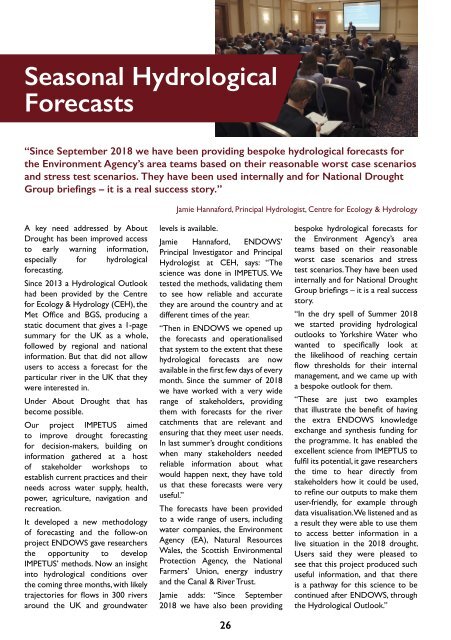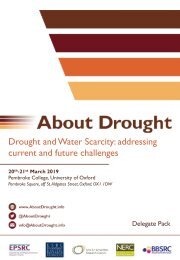About Drought Handbook: Outputs & Impacts
As the UK’s £12m Drought and Water Scarcity (DWS) research programme reaches its conclusion with a final event at The Royal Society in London, this handbook draws together the key outputs and outcomes. The book also features a series of interviews with our leading stakeholders, which highlight how successfully we have met our objectives to produce cutting-edge science that has made a demonstrable impact on how decision-makers manage water scarcity in the UK.
As the UK’s £12m Drought and Water Scarcity (DWS) research programme reaches its conclusion with a final event at The Royal Society in London, this handbook draws together the key outputs and outcomes. The book also features a series of interviews with our leading stakeholders, which highlight how successfully we have met our objectives to produce cutting-edge science that has made a demonstrable impact on how decision-makers manage water scarcity in the UK.
- No tags were found...
Create successful ePaper yourself
Turn your PDF publications into a flip-book with our unique Google optimized e-Paper software.
Seasonal Hydrological<br />
Forecasts<br />
“Since September 2018 we have been providing bespoke hydrological forecasts for<br />
the Environment Agency’s area teams based on their reasonable worst case scenarios<br />
and stress test scenarios. They have been used internally and for National <strong>Drought</strong><br />
Group briefings – it is a real success story.”<br />
Jamie Hannaford, Principal Hydrologist, Centre for Ecology & Hydrology<br />
A key need addressed by <strong>About</strong><br />
<strong>Drought</strong> has been improved access<br />
to early warning information,<br />
especially for hydrological<br />
forecasting.<br />
Since 2013 a Hydrological Outlook<br />
had been provided by the Centre<br />
for Ecology & Hydrology (CEH), the<br />
Met Office and BGS, producing a<br />
static document that gives a 1-page<br />
summary for the UK as a whole,<br />
followed by regional and national<br />
information. But that did not allow<br />
users to access a forecast for the<br />
particular river in the UK that they<br />
were interested in.<br />
Under <strong>About</strong> <strong>Drought</strong> that has<br />
become possible.<br />
Our project IMPETUS aimed<br />
to improve drought forecasting<br />
for decision-makers, building on<br />
information gathered at a host<br />
of stakeholder workshops to<br />
establish current practices and their<br />
needs across water supply, health,<br />
power, agriculture, navigation and<br />
recreation.<br />
It developed a new methodology<br />
of forecasting and the follow-on<br />
project ENDOWS gave researchers<br />
the opportunity to develop<br />
IMPETUS’ methods. Now an insight<br />
into hydrological conditions over<br />
the coming three months, with likely<br />
trajectories for flows in 300 rivers<br />
around the UK and groundwater<br />
levels is available.<br />
Jamie Hannaford, ENDOWS’<br />
Principal Investigator and Principal<br />
Hydrologist at CEH, says: “The<br />
science was done in IMPETUS. We<br />
tested the methods, validating them<br />
to see how reliable and accurate<br />
they are around the country and at<br />
different times of the year.<br />
“Then in ENDOWS we opened up<br />
the forecasts and operationalised<br />
that system to the extent that these<br />
hydrological forecasts are now<br />
available in the first few days of every<br />
month. Since the summer of 2018<br />
we have worked with a very wide<br />
range of stakeholders, providing<br />
them with forecasts for the river<br />
catchments that are relevant and<br />
ensuring that they meet user needs.<br />
In last summer’s drought conditions<br />
when many stakeholders needed<br />
reliable information about what<br />
would happen next, they have told<br />
us that these forecasts were very<br />
useful.”<br />
The forecasts have been provided<br />
to a wide range of users, including<br />
water companies, the Environment<br />
Agency (EA), Natural Resources<br />
Wales, the Scottish Environmental<br />
Protection Agency, the National<br />
Farmers’ Union, energy industry<br />
and the Canal & River Trust.<br />
Jamie adds: “Since September<br />
2018 we have also been providing<br />
26<br />
bespoke hydrological forecasts for<br />
the Environment Agency’s area<br />
teams based on their reasonable<br />
worst case scenarios and stress<br />
test scenarios. They have been used<br />
internally and for National <strong>Drought</strong><br />
Group briefings – it is a real success<br />
story.<br />
“In the dry spell of Summer 2018<br />
we started providing hydrological<br />
outlooks to Yorkshire Water who<br />
wanted to specifically look at<br />
the likelihood of reaching certain<br />
flow thresholds for their internal<br />
management, and we came up with<br />
a bespoke outlook for them.<br />
“These are just two examples<br />
that illustrate the benefit of having<br />
the extra ENDOWS knowledge<br />
exchange and synthesis funding for<br />
the programme. It has enabled the<br />
excellent science from IMEPTUS to<br />
fulfil its potential, it gave researchers<br />
the time to hear directly from<br />
stakeholders how it could be used,<br />
to refine our outputs to make them<br />
user-friendly, for example through<br />
data visualisation. We listened and as<br />
a result they were able to use them<br />
to access better information in a<br />
live situation in the 2018 drought.<br />
Users said they were pleased to<br />
see that this project produced such<br />
useful information, and that there<br />
is a pathway for this science to be<br />
continued after ENDOWS, through<br />
the Hydrological Outlook.”




